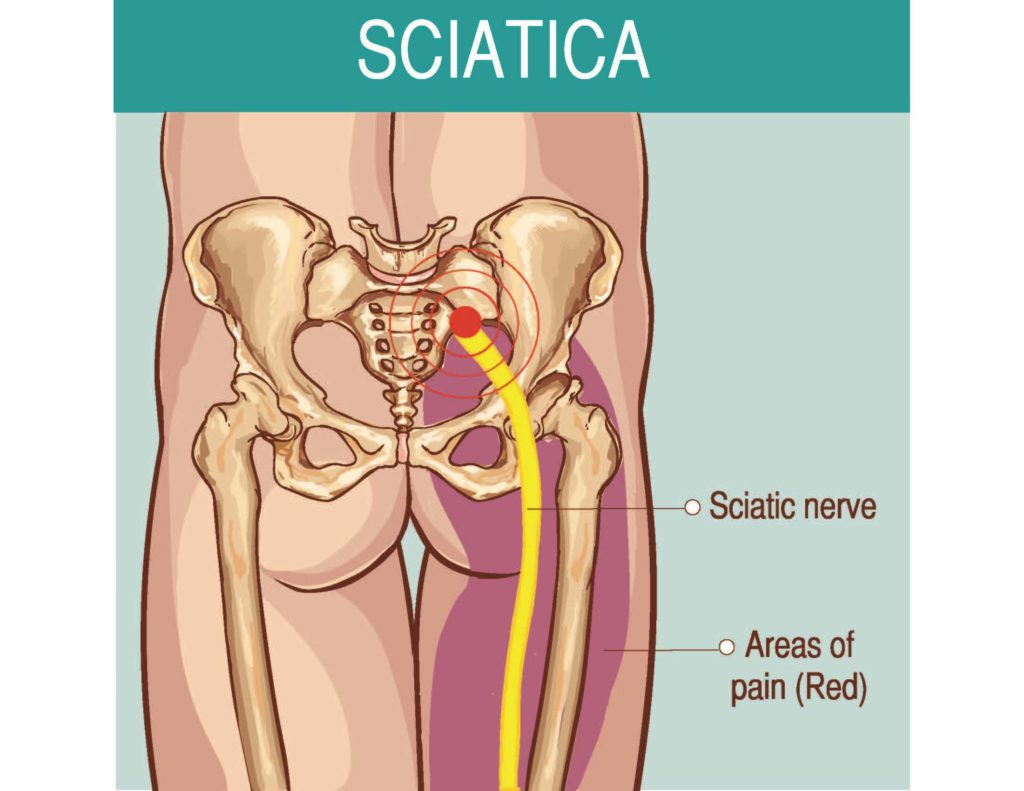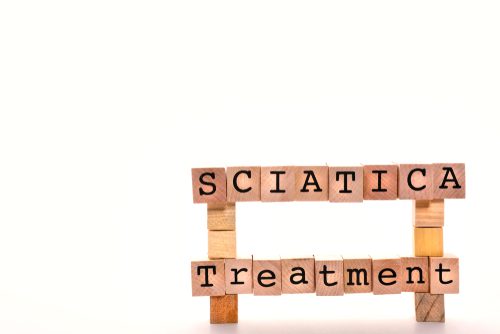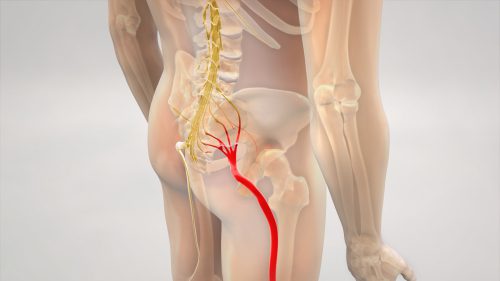Sciatica is a term used we commonly hear in clinic to describe nerve pain in the thigh and leg that technically is caused by irritation and/or compression of the sciatic nerve. This condition originates in the lower back from the L5 and S1 nerve roots, radiates deep into the buttock, and travels down the leg.

Is Sciatica Really Radiculopathy?
Most people with sciatic pain really suffer from radiculopathy (which refers to injury of the nerve root) rather than injury to the sciatic nerve per se. Radiculopathy causes pain by the compression of a spinal nerve root(s). This occurs when one or more nerve roots from L4 to S3 are irritated or compressed due to conditions such as a herniated disc, spinal stenosis, or degeneration of that segment of the spine. Radicular pain from the nerve root is typically felt in the thigh, calf, and/or foot—away from the actual source of the problem. It can be confused with actual sciatic nerve injury particularly when the L5 and/or S1 nerve roots are involved.
Sciatica, the term commonly used to describe radicular pain along the sciatic nerve, describes where the pain is felt but is not an actual diagnosis. The clinical diagnosis is usually arrived at through a combination of the patient’s history (including a description of the pain) and a physical exam. Imaging studies (MRI, CT-myelogram) are used to confirm the diagnosis and will typically show the impingement on the affected nerve root. EMG and nerve conduction studies are also helpful by physiologically testing the nerves and nerve roots for abnormal signals that could indicate nerve damage.
What Does Sciatica Feel Like?
The symptoms of sciatica are commonly felt along the path of the large sciatic nerve. This condition is often characterized by one or more of the following symptoms:
- Pain. Pain is typically felt like a constant burning sensation or a shooting pain starting in the lower back or buttock and radiating down the back of the thigh and leg and/or foot.
- Numbness. Pain may be accompanied by numbness in the back of the thigh and/or leg. Sometimes, tingling and/or weakness may also be present.
- One-sided symptoms. Sciatica typically affects one leg. The condition often results in a feeling of heaviness in the affected leg. At times, both legs may be affected together.
- Posture induced symptoms. Symptoms may feel worse while sitting, trying to stand up, bending the spine forward, twisting the spine, lying down, and/or while coughing. The symptoms may be relieved by walking, bending backwards or applying a heat pack over the rear pelvic region.

It is important to note that any type of lower back pain or radiating leg pain is not sciatica. Sciatica is specific to pain that originates from the sciatic nerve.
Sciatica pain may be accompanied by other symptoms and typically affects one or more regions in the low back, thigh, leg, and foot. If the duration of pain is less than 8 weeks, it is called acute sciatica. Pain duration of more than 3-6 months is referred to as chronic sciatica.
Pain is usually the first symptom of sciatica and typically indicates nerve irritation or inflammation. Most commonly, a sharp, burning, or searing pain may be felt as well.
A few examples of other types of pain that may be felt include:
- Electric shock-like, shooting pain
- Throbbing or pulsating pain
- Constant dull ache
- Discomfort that comes and goes
It is advisable to treat sciatica as early as possible in order to avoid the progression of symptoms. Sciatica treatment may include both nonsurgical and surgical methods. Typically, nonsurgical methods are tried first. Surgery may be indicated when the underlying cause is severe, does not respond to treatment and/or progressive neurological deficits such as leg weakness occurs.
Treatment for Sciatica

First line treatments of sciatica typically include some combination of physical therapy, medications, therapeutic injections, and alternative therapies.
Acute sciatica usually gets better with 4 to 6 weeks of nonsurgical treatment. For chronic sciatica, treatment time may take longer and may depend on the underlying cause.
Physical Therapy for Sciatica
Physical therapy incorporates a combination of strengthening, stretching, and conditioning and is a central component of the treatment plan. Therapeutic exercises are usually added to a physical therapy program.
The goals of physical therapy and exercises for sciatica include:
- Strengthen the spine and muscles of the lower back, abdomen, buttocks, and hip
- Increase core strength
- Stretch tight and inflexible muscles, such as hamstrings
- Encourage the exchange of fluids and nutrients in the body by light aerobic exercises such as walking, swimming, or pool therapy
While some rest or activity modification may be necessary, it is important to maintain as much activity as possible and avoid prolonged periods of physical inactiveness or bedrest.
Certain exercises to treat sciatica should be specific to the underlying cause. Trained health professionals, such as physiatrists, physical therapists, chiropractors or qualified certified athletic trainers can help formulate an effective treatment plan to relieve sciatica pain through exercise and physical therapy.
Medication for Sciatica Pain
Both prescription and over-the-counter (OTC) medications may be used to relieve sciatica pain. A few examples of medications used to treat sciatica pain include:
- Nonsteroidal anti-inflammatory drugs (NSAIDS), such as ibuprofen or naproxen
- Oral steroids, such as prednisone
- Anti-nerve pain medications, such as gabapentin
- Antidepressants, such as amitriptyline or duloxetine
These drugs are usually taken in order to obtain pain relief and allow the patient to participate in physical therapy.
Lumbar Therapeutic Injections for Sciatica
Lumbar therapeutic injections may help treat pain stemming from conditions that affect the sciatic nerve.
Injections are used with the goal of providing enough pain relief to allow the patient to fully participate in, and benefit from a physical therapy program. Injections also serve a function in diagnosing the source of the pain and may be used to identify the target nerves.
The most common types of injection for sciatic pain relief include Epidural Steroid Injections. Epidural steroid injections may help relieve sciatic pain stemming from conditions such as spinal stenosis, disc herniation, or degenerative disc disease. The primary goals of this treatment include:
- Control the inflammatory response around the nerve root from chemical and mechanical sources of pain, such as a herniated disc or a degenerated disc
- Reduce the activity of the immune system to decrease the production of inflammatory cells in the body
The steroids injected in the epidural space under careful image guidance, bathe the nerve endings and other tissues, causing an anti-inflammatory effect.
As a general rule, if nonsurgical methods fail to provide relief after 8-12 weeks of treatment or if neurologic deficits (such as leg weakness) increase, surgery should be considered.

Eduardo Elizondo
MDBoard-Certified Physical Medicine & Rehabilitation
Board-Certified Electrodiagnostic Medicine
Certified Life Care Planner




